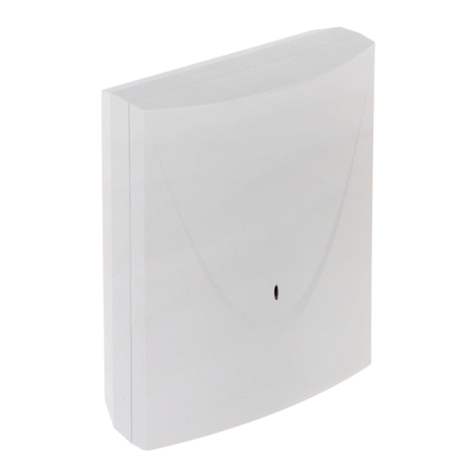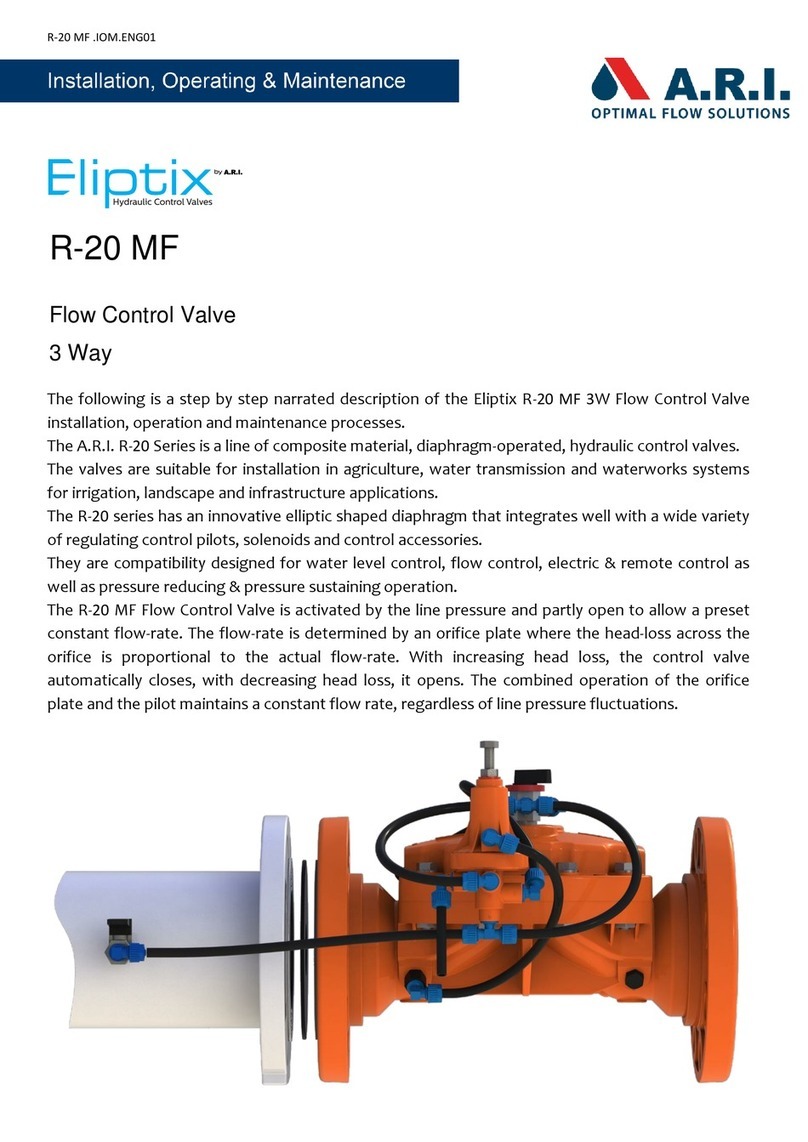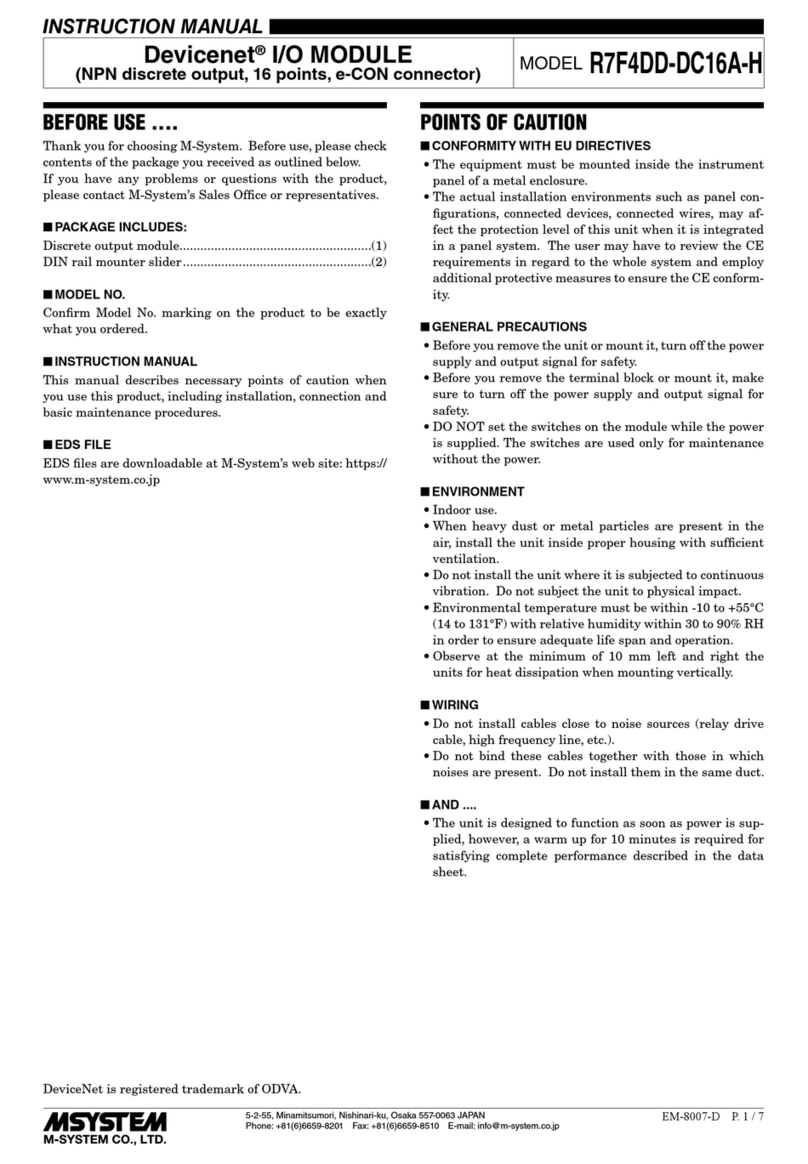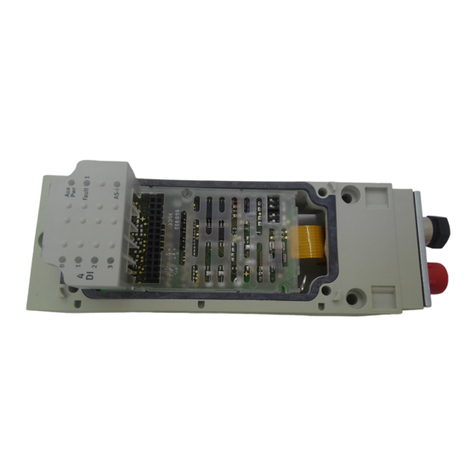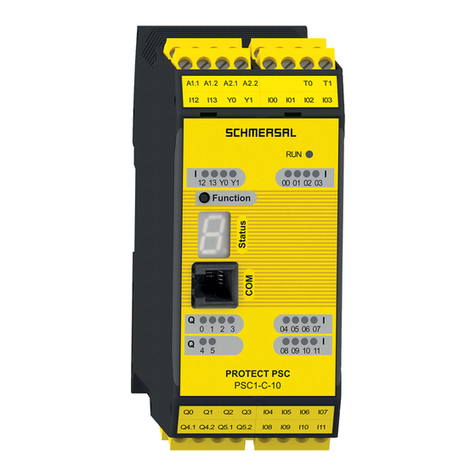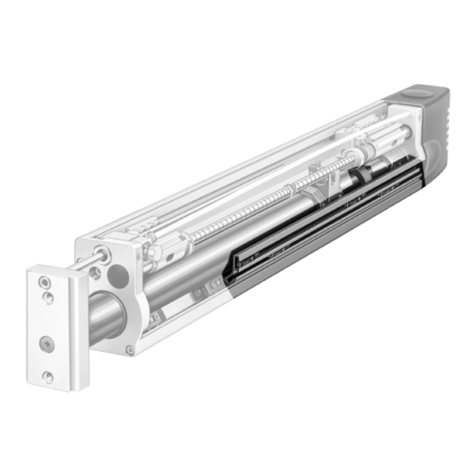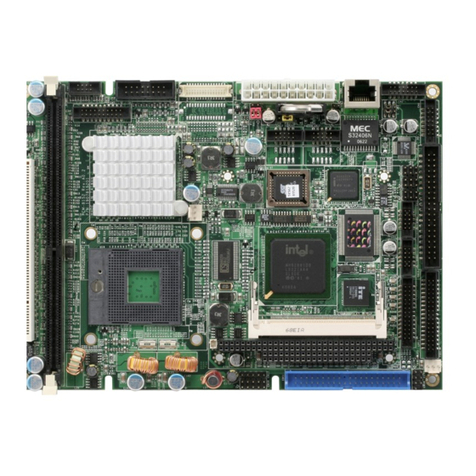After Later Audio BENJOLIN V2 User manual

BENJOLIN V2 MANUAL
Manual Revision B
HISTORY
The Benjolin is originally a ‘patch in a box’, meaning a couple of
‘modules’ patched up in a fixed way and put in a box to create a
specific kind of standalone instrument. This patch is not intended to
create music based on melodies, harmonies and specific rhythms, but to
create ‘sound scapes’ of pure electronic sounds. Meaning it’s an
‘electronic music instrument’, an instrument to create electronic
music in its most pure and abstract forms.
The first version of the Benjolin was designed as a kit in the year
2009, for the purpose to organize DIY workshops where people could
build a Benjolin themselves. Every participant was taken by the hand
to successfully build one, even if they had never built a piece of
electronics before and/or used a soldering iron. A necessary
requirement for the design was to keep it simple, it should not take
more as about four hours for a complete novice to build a kit. And so
the first Benjolin was fully based on the punk principle of ‘the
minimum for the maximum’.
Hundreds of people all over the world have built Benjolins in these
workshops and virtually everyone succeeded in finishing and go home
with a properly working Benjolin. At this time the technique of
circuit bending was popular, and the name Benjolin originates as ‘an
electronic crossover between a banjo and a violin’ that is ‘bent by
design’. The banjo being an instrument associated with popular music
and the violin being associated with a bit elite music, and the
built-in crazy behavior associated with circuit bending. So, an
instrument for everybody, to give incredible fun while exploring its
behavior. As a standalone instrument this DIY Benjolin was a good
companion for guitar stompboxes and other effects units, with line
level audio inputs.
Soon it became clear that the Benjolin was actually very useful in
creating pure and abstract electronic music. The kind of music that
the designer of the Benjolin thinks began with e.g. the soundtrack of
the movie Forbidden Planet around the year 1956. Several composers and

performers of electronic music and movie tracks discovered the
Benjolin. And it also became the guilty pleasure of many synth and
keyboard players that normally would play melodies and harmonies in
proper rock songs, but also like to experiment with sounds when no one
else is around, just for the fun of it.
As this first Benjolin version was a gift to the diy community the
designer was always hesitant of making a Eurorack version. There has
been an officially licensed Benjolin v1 Eurorack version made by Epoch
Modular. The downside of this v1 was that because of the design
restrictions of the original diy workshop kit many extra possibilities
were not present. Signal levels were also not very compatible with
Eurorack, as the original schematic had the specific property that the
audio output could be used directly with stompboxes, guitar amps and
living room hifi amps.
It’s now well over ten years after the first Benjolin workshops, and
some time ago the Epoch version disappeared from the market. This made
After Later Audio and Rob Hordijk decide to join hands, and that now
was the time to make a new design specifically for Eurorack with many
more features brought to the outside of the module and inputs and
outputs properly specified to be used in a Eurorack setup. And so in
the summer of 2020 the Eurorack Benjolin v2 was born.
DESCRIPTION
The Benjolin ‘patch’ is based on four ‘modules’, or function blocks.
There are two voltage-controlled oscillators with a very wide pitch
range. These two VCOs are named OSC1 and OSC2. Third is a 12dB
voltage-controlled filter simply named the filter. In this text it is
also named the VCF. This filter has exceptionally good ‘pinging’
characteristics, and the cutoff can be modulated deeply at the highest
audio rates. The fourth block is a special ‘interference pattern
generator’ function, creating voltage patterns from the signals coming
from the two oscillators. The pattern generator architecture is unique
enough that it is entitled to its own name and many years ago it was
baptized as a Rungler. So, just like how an oscillator is oscillating,
a Rungler is Rungling. In its simplest form a Rungler needs two pulse
signals as inputs, and from these two pulses it can create several
output signals that are basically stepped patterns of specific

lengths. Patterns are either slowly changing or can be frozen in a
short loop. What sets a Rungler apart from e.g. a sequencer is its
property that patterns are dynamic, so they can be constantly
changing. There is also a certain amount of control over when the
pattern changes.
The output signals of the VCOs and the Rungler are used to cross-
modulate and self-modulate themselves and the other functions. These
cross-modulations and feedback-modulations together create a system
that is capable of myriads of different and dynamically changing
sounds. Still, all those sounds will have one specific character, and
that is the ‘sound’ of the Benjolin.
To summarize, there are two VCOs, one VCF and the Rungler in the
Benjolin. Each of these four blocks can be used separately as an
individual module, having its own signal and modulation inputs and
outputs. So, it’s no problem at all to use the VCOs as extra
modulation signal oscillators in a larger patch, if you just need an
extra LFO. Also the filter can be used as a separate filter, or even
as a separate sinewave oscillator. The Rungler can also be used
separately, its functions will be described in more detail later.
It is highly recommended to spend some time reading the signal flow
and playing with the module. It should help you get a feel for how to
control this complicated chaos machine.
New to the Benjolin V2:
Reworked oscillator and filter sections
All levels are adjusted to Eurorack standards
Two different steps modes (8/16 and 127)
Double and single clock rate
Externally clockable
External filter input with blend control
Support for the Turing Machine expanders (with Tom’s permission)

OSCILLATORS
Oscillator 1 and 2 have identical controls and inputs/outputs.
Pitch: Coarse pitch control to control the frequency of each oscillator.
Rungler: The ammount of Rungler stepped CV that is applied to each
oscillator.
CV Pitch: CV pitch input with an attenuator to control the amount of impact
on the pitch of the oscillator. The jack is normalled to the triangle output
of the opposite oscillator (OSC1 CV pitch input is normalled to the OSC2
triangle wave).
Waveform Outputs: Triangle and Square/Pulse outputs for each oscillator.
It is important to note that the oscillators sections do not support v/oct.
This might feel odd but once you play with the module it will become clear
why this is not important.

RUNGLER
The Rungler section is centered on a shift register that uses an R2R DAC to
create a stepped CV voltage. There are two inputs into the shift register,
the data to sample (which comes from OSC1) and clock speed (which comes from
OSC2). You can play with the speed of both of the oscillators and see how
they influence the stepped CV output from the Rungler.
Change: Controls how much the rungler is allowed to take in new data, and
therefore change the stepped CV output. Full CCW and CW does not allow new
data into the shift register, and therefore locks the stepped CV loop. When
the knob is at the midpoint/top, the Rungler takes in all new data and does
not recirculate any data.
Steps: Toggle switch to control how the data in the shift register is
recirculated. There are two modes of 8/16 steps and 127 steps.
Rate: Controls how the clock on the shift register is advanced. The single
clock rate only advances on the rising edge. The double clock rate will
advance on both the rising and falling edge of the clock signal.

Rungler: The actual stepped CV output that ranges from -5V to +5V.
Steps/Rate CV Inputs: The switches are configured so that when the switch is
up you will get the same behavior as passing a high voltage.
XOR: The output of one bit from the shift register resulting in a random gate
output.
Clock: Control the clock rate of the shift register and therefore the stepped
CV output of the Rungler. This jack is normalled to the frequency of OSC2.

MIXER
Controls the input into the filter section.
PWM: The output of the comparator of the triangle wave from OSC1 and OSC2
resulting in a square wave with variable width.
Ext In: An external audio input
Input: Controls the blend between PWM and Ext In that is fed to the filter
input.

FILTER
Freq: Controls the cutoff frequency of the multimode filter
Resonance: Controls the resonance of the multimode filter. Delivers more
wetness than a Seattle winter.
Rungler: The amount of Rungler stepped CV that is applied to cutoff
frequency.
CV Freq: CV pitch input with an attenuator to control the amount of impact on
the cutoff frequency.
HP: Highpass output of the filter.
BP: Bandpass output of the filter
LP: Lowpass output of the filter.

SIGNAL FLOW

PATCH SUGGESTIONS
1) The filter can be changed easily into a pure sinewave oscillator
by feeding back the BP output to the crossfader input, setting
the crossfader to the ext-in position and setting the resonance
knob about ¾ open. When resonance would be fully open you will
hear clipping in the sinewave. The sine signal can be taken from
both the LP and the HP outputs.
2) When you would want to do FM crossmodulation with two of the
Benjolin filters used as sine oscs, then you apply this BP
feedback so both filters turn into sinewave oscs, listen to the
LP outputs and crossconnect the HP outputs to the other filter
modulation inputs.
GETTING MORE INTIMATE WITH YOU BENJOLIN
Undoubtedly you have already tried out the Benjolin V2 before reading
the manual or this text. Most probably you got lots of totally crazy
sounds and undoubtedly have wondered if it is at all possible to get
any kind of control over the sounds. Well, for that you will have to
get to know the Benjolin at a much more intimate level. Which will
take some time. You will learn that it will never be possible to
predict the behaviour in detail, but it is very well possible to
predict the behaviour at a more global level. And that way be able to
actually incorporate it in a performance or composition. Though the
Benjolin will always request from you to anticipate and improvise on
what you hear.
To get more familiar with your Benjolin it is a good idea to first
explore the four functions one at a time. But before going into the
rungler function it is a good idea to get completely familiar with the
two vcos and the vcf first.
The vcos are equal in their design. Both produce a 10V pp triangle
wave and a 10V pp square wave as output, available on mini-jack
connectors. Both also have a mini-jack cv pitch input with an
associated modulation level knob. This means that there is a

‘symmetry’ between the two vcos, each could e.g. go to a left and a
right audio channel on a mixer, and then you can apply crossmodulation
between the two vcos. This would give you two related drone signals,
each on its own channel.
The total range of the vco pitch knob is from one cycle every 45
seconds at the ccw position to about 8kHz at the cw position. cw and
ccw stand for clockwise and counterclockwise. The pitch knobs have the
lfo range at the left side and the audio range at the right side. At
the 12 o’clock position the pitch is roughly around 20 Hz to 40Hz, the
area at the top of the lfo range and at the bottom of the audio range.
There is some tolerance in the analog electronic components, meaning
there may be a slight difference between the two pitches when the
pitch knobs are set fully cw or ccw. But these slight differences are
the charm of analog and help causing the organic quality of the analog
sound.
The cv pitch curve is close to 1V/Oct, but these oscillators are not
intended to play melodies in e.g. a perfectly tuned equally tempered
12 note scale. Instead they are intended to produce pitches over a
very wide pitch range, of over eightteen octaves. And to be modulated
over that very wide range as well, at slow rates and at very high
audio rates. This is what these oscillators are very good at: to be
modulated. Though at the expence of a slightly inaccurate 1V/Oct
scale.
CHECK IT OUT!
Lets start with the first vco. You can connect the triangle wave
output of the leftmost vco to your mixing desk, close the rungler and
cv pitch knobs, set the osc1 pitch knob to about 2 o’clock and then
slowly open the fader on the mixing desk. Remember that this is a hot
signal, so use a mixer channel that can handle such a signal without
overloading its input. You should now hear the typical ‘hollow’ sound
of a triangle wave at a moderate pitch.
It is possible to do some waveshaping on this triangle wave, though
this will change the pitch as well. For this you connect a short mini-
jack cable between the osc1 pul1 output and the osc1 cv pitch input.
Now you slowly open the cv pitch modulation level knob above the mini-
jack connector. You should hear two things happening, first you hear a

detuning and second you hear the character of the sound change from
the typical ‘hollow’ triangle wave to a much more bright sawtooth
wave.
This effect may not be very spectacular yet, but when the vco is used
at lfo rates changing the waveshape this way can produce nice results.
NORMALIZATION
If there is no jack connected to a cv pitch mini-jack connector on a
vco then the mini-jack connector is normalized to the trianglewave
output of the other vco. This means that without jacks inserted in the
cv pitch connectors osc1 is modulating osc2 and osc2 is modulating
osc1. Normalization means that the circuitry uses signal switches
built-in in the mini-jack connectors. This happens behind the
frontpanel, so its invisible, but it basically means that if there is
no jack in the connector the connector output is connected to some
internal signal. And the moment when a jack is inserted in the
connector the internal switch breaks the internal connection and it is
the signal from the jack that takes over instead of the internal
signal.
See it like this: if no jack is connected to the osc1 cv pitch
connector then osc1 will use the triangle wave of osc2 for modulation
when the cv pitch knob is opened. Inserting a jack will ‘override’
this connection and osc1 will use the signal from the cable when the
cv pitch knob is opened.
So, lets listen to the triangle output of osc2 and set osc2 to a pitch
in the audio range, like at 2 o’clock. Now set the pitch of osc1 into
the lfo range, like at 9 o’clock, and slowly open the osc2 cv pitch
knob. You will hear the triangle of osc1 sweep the pitch of osc2 up
and down. Now connect a short mini-jack cable from the pul1 connector
to the cv pitch input connector of osc2. Instead of a sweeping sound
you will now hear a modulation between two fixed pitches, caused by
the low and high voltage levels of the osc1 square wave.
If you now disconnect the short cable from the cv pitch input of osc2
and instead connect it between the PUL1 connector and the cv pitch
input of osc1 and also open the osc1 cv pitch knob you hear that the
modulation pattern changes from up and down sweeps of equal length
into longer upsweep and shorter downsweep times.

Now you should think of every possible combination of patching only
the four osc outputs and two osc inputs, while listening directly to
one or more of the four outputs. Both selfmodulation and
crossmodulation are possible, and all create their own specific
effects.
LAWS OF FREQUENCY MODULATION
Frequency modulation of one oscillator with another oscillator can be
expressed in mathematical terms and extensive calculations can be done
to predict the results in terms of the harmonic content of the
resulting sound spectrum. However, this math is just super complex and
it needs a degree in mathematics to understand the type of functions
and formulas. These kind of calculations you do not want to do. And
they also do not give practical guidelines on the behaviour of
frequency modulation.
Instead there is one rule of thumb that you need to remember and that
is:
A low pitch can easily modulate a high pitch over a very wide range,
but a high pitch can not so easily modulate a low pitch over the same
range.
This means that in general the pitch of the oscillator that is
modulating the other oscillator should be lower or equal to the pitch
of the modulated oscillator. You can make it a bit higher and still
hear some effects, but if you make it significantly higher you will
hear that the frequency modulation effect disappears, no matter if you
increase the modulation level or not. The sonic effect that remains is
more like the signal is digitally sampled at a samplerate equal to the
modulating pitch.
You can test this principle by letting osc1 modulate osc2 and listen
to the osc2 triangle wave output. If you keep the cv pitch knob at the
same level and tune the oscs from the lfo range into the audio range
and back you hear that the lfo can easily modulate the audio pitch but
an audio pitch doesn’t really do a lot on an lfo range.
There is a way to change this behaviour and get an equal modulation
depth despite pitches, but this involves the addition of extra
circuitry. In fact it would need a s&h circuit, which changes the

mathematics from frequency modulation formulas into statistic
functions. But such circuitry is not present in the Benjolin, and so
you need to remember that low pitches easily modulate high pitches but
high pitches hardly modulate low pitches at all.
Still, later we will see that the rungler is actually behaving like
how a S&H would behave and that when using the rungler outputs the
modulation mathematics follow the statistic functions and not per se
e.g. the frequency modulation Bessel functions.
PWM MIXER FOR THE OSC1 and OSC2 SIGNALS
There is an inheritance from the original diy design, as the original
was designed to have a little knobs as possible, just to keep things
simple. To mix the signals from the two vcos before going into the
filter the decision was made not to give each of them its own output
level mixer knob, but instead create a fixed mix of the two vcos.
However, this mix is not a sum of two vco output signals, but the
‘compare’ of two vco output signals. In fact, it are the two triangle
wave signals that come from the vcos that are fed into a ‘comparator’
circuit, which outputs a low pulse if the osc1 triangle is at a
momentary higher level and a high pulse if the osc2 triangle is at a
momentary higher level. If one vco is running at audio rate and the
other at a low lfo rate this will create a deep pwm sound, pwm meaning
Pulse Width Modulation. When the pitch of the vco that is at an lfo
rate is increased into the audio range the result will start to sound
like ringmodulation. This pwm signal is what is fed into one of the
inputs of the crossfader at the input of the vcf. If you try out this
pwm sound you will instantly recognize its potential on spacey drone
sounds, as the pwm has a strong ‘spacious’ character. It sounds very
similar to two musical instruments playing in unison.
If both vcos are tuned in the lfo range the pwm signal sounds like
pulses with a distinct ‘polyrhythm’ character. When feeding these
pulses into the vcf set to maximum resonance you will create a
percussive rhythm. Modulating the vcf through the cv freq from one of
the vco outputs can modulate the timbre in the ‘beat’ of the rhythm.
THE FILTER

The vcf is a more or less ‘standard’ voltage controlled 12dB state-
variable filter. It has a single knob ‘equal loudness’ crossfade mixer
on its input to allow easy selection of either the internal pwm sound
or a sound that comes in at the ext in mini-jack connector. If there
is no jack inserted in this connector the crossfade mixer knob can be
used as a volume control, ccw is silent and cw sends the internal pwm
mixer sound signal to the filter. Note that this crossfader fades
between the internal pwm signal and an external signal, and nót
between the two vcos.
Of course you can also route any of the osc outputs to the crossfader
external input, this way any signal can be used as input to the filter
instead of the pwm signal. A crossfade mix of e.g. the pul1 connector
on vco1 and the internal pwm can be used to set a subtler phasing.
The filter has three outputs: lp = lowpass, bp = bandpass and hp =
highpass, as is common with 12dB state variable filter types. The
advantage of a state variable filter is that it can be configured in a
way that by default it is at its maximum resonanant setting. Then this
resonance can be reduced by ‘damping’ the filter using the resonance
knob. The Benjolin filter is set up in a way that in normal use and
resonance set to fully cw it is on the brink of oscillation. If a
sharp lfo pulse, e.g. the flank from a pulse wave or from a sawtooth
wave is fed into the filter it will ‘ping’. Meaning a short burst of
sinewave cycles is produced that dies out after a second or so. This
creates a ‘percussive’ effect. If this ‘percussive ping’ is taken from
the bp output the initial flank will not be present in the output
signal and a clean burst of sinewave cycles is heard. This ‘ping’ can
be given more sonic character by feeding e.g. an audiorate triangle
wave signal into the vcf cv freq mini-jack input and slightly open its
associated modulation level knob.
By mixing the lp, bp and hp outputs on an external mixer it is
possible to create ‘in between’ filter curves. The phase relation
between the lp, bp and hp outputs is 0 degree, 90 degree and 0 degree,
meaning that the lp and hp are not in antiphase. To create a notch
filter you will have to invert either the lp or the hp with an
external module before mixing them to create the notch.
To use the vcf as a sinewave oscillator with a continuous sinewave
output you connect the bp output to the vcf ext in connector, turn the

crossfade mixer knob fully left and set the resonance knob to a 12
o’clock position. When opening the resonance knob further in the cw
direction will start clipping the tops of the sinewave cycles. You can
hear the sinewave on both the lp and the hp outputs. By using an
external multiple you can also split the bp signal and listen to the
bp signal while feeding it back to cause the oscillation.
If you listen to the lp output you can additionally connect the hp
output to the cv freq input of the vcf, opening the cv freq knob will
now ‘morph’ the sinewave to a bright sawtooth wave, though at the
expense of some detuning. You can also make this hp -> cv freq
connection when doing normal filtering to change the brightness of the
filtered sound.
You will find out that this little vcf filter has many not so obvious
extra features that are great to discover and play with. Especially
when creating drones you will notice that the extra possible
modulation paths in the filter can subtly change the character of the
drone over wide ranges. In this case do not simply use knobs in their
fully closed or fully opened positions, but turn them very slowly to
discover the sonic areas and sweet spots you like most.

THE RUNGLER
The rungler circuit is based on a binary device named a shift
register. This shift register is a cascaded group of one-bit memory
cells (D-type flip-flops), all sharing the same ‘write’ clock pulse.
On clocking each memory cell passes its stored value of either a one
or a zero to the next memory cell and takes over the value of the
previous memory cell. This way a pattern of bits in the memory cells
is shifter one position to the right on each clock pulse, taking in a
new bit from a data input at the beginnning of the cascade and
dropping the last bit that gets shifted out at the end of the cascade.
This shift register circuit is found in almost all digital devices, as
its most common use is to convert parallel data into a serial data
stream and convert a serial data stream back into parallel data. This
conversion process is at the base of e.g usb connections, Ethernet
network connections, etc. But this shift register circuit can be used
for many other purposes as well, e.g. sequencing, noise generation
and arbitrary waveform generation. The rungler is a special use of the
shift register that is somewhere half way between sequencing and noise
generation.
There are several shift register chips from several different logic
chip families available. The original Benjolin used a cmos logic
cd4021b chip. This cd4021b has eight cascaded flipflops, a serial data
input, a clock input and three outputs from the last three memory
cells. In the v2 version a cd4015b is used, which is functionally
compatible to the cd4021b, but features outputs for all eight memory
cells. These eight bit outputs are available on one of the backside
expansion connectors.
In essence a rungler circuit takes one output bit from the shift
register, in general the last bit of the cascade, modifies this bit
with an external modification bit and then feeds the modified result
back into the serial data input of the shift register. On the next
clock pulse this modified bit is fed back into the shift register.
This will create a short loop of bits that form a serial bit pattern.
This pattern is changed by the modification caused by the external
bit. Then a few output bits are connected to a digital to analog

converter to produce a stepped analog output voltage. This analog
voltage changes to another value when a clock pulse is applied to the
rungler circuit.
The Benjolin v2 rungler uses three bits for the DA converter, which
can produce eight voltage levels at roughly -4V, -3V, -2V, -1V, 0V,
+1V, +2V and +3V.
When there are eight memory cells in the shift register and three of
them are used to connect to the DA then changing only one bit in the
circulating pattern will influence the analog values of three steps.
It is this property that actually makes its behaviour interesting.
The idea of a rungler is to use two squarewave vcos to drive the
circuit, one is driving the clock input and the other provides the
external modification bit for the shift register feedback loop. The
simplest possible modification is a one bit multiplication, also named
a logic exclusive or or xor function. What this does is, depending on
the value of the external bit, either let the feedback bit pass
unaltered or negate the feedback bit to its inversion. If the square
wave that produces the modification bit is at a much lower rate as
the oscillator that clocks the shift register then the pattern changes
on every flank of the modification bit, so the moment when the
modification bit goes from low to high the pattern will change and
when it changes from high to low it will also change. Additionally the
length of the pattern will be twice as long if the modification bit
causes an inversion. So, a change in level of the modification bit
will change the pattern content ánd the pattern length, doubling or
halving the length on each change.
The rungler circuit is at first sight very similar to shift register
based digital noise generators, but differs at some crucial points.
What it shares with the noise generator circuits is that it uses
feedback. But the way feedback is handled is different. The digital
noise generators are set up to give a pseudo-random sequence of the
maximum length possible with the amount of flip-flops in the cascade.
Which for a shift register cascade length of ‘n’ is 2^n - 1. The
rungler circuit produces sequences that are either n or n*2. So, while
an ‘eight bit’ shift register would produce a pseudo-random sequence
of length 255, where each value between 1 and 255 would appear once
though in a scrambled time order, this eight bit shift register used

as a rungler circuit would produce sequences of either eight or
sixteen steps. But the pattern would be constantly changing at a
certain rate, or be frozen in a loop. The relatively short patterns
are much more useful musically compared to the longer pseudo-random
sequence of a digital noise generator where patterns sound to go
nowhere. An 127 step pseudo-random sequence mode is added in the v2
version rungler, which can easily turn the rungler into a white noise
generator, as the modification bit can scramble the 127 steps in a way
that the sequence actually becomes truely random.
The rungler circuit has two main outputs, the connector named rungler
and the connector named xor. On the rungler connector is the stepped
voltage with the eight possible analog output levels. The xor output
is the serial stream of bits as it is clocked into the shift register.
Both signals have their uses. The analog stepped signal can be used as
a modulation signal to modulate pitches, filter cutoffs, etc. The one
bit xor signal can be used as a gate or clock signal to trigger
envelopes, sequencers, logic circuits, reset lfos, etc.
So, a basic rungler circuit has two internal inputs and at least two
outputs. The two inputs are for the clock and for the modification
bit, and there can be one or more stepped analog outputs and one or
more digital bit outputs. If the shift register has a length of eight
steps, and for each step a physical bit output is present on the chip,
then there are many possibilities to connect DA converters to these
bit outputs. However its best to keep things simple but effective.
Instead of going for a ‘Jack of all trades but master of none’ design
the Benjolin is based on the ‘minimum for the maximum’ principle.
Meaning that only those output options that are the most effective are
implemented. This as the trick is not really in the rungler output
signal itself, but in what is done with this output signal to create
‘behaviour’ for the total of the Benjolin design.
Given the fact that a rungler circuit has two basic inputs the
architecture of the Benjolin with its two wide range vcos instantly
becomes clear, as these two vcos are in essence the two motors that
drive the rungler circuit. The vco outputs together with the rungler
outputs present us with some very interesting signals at either lfo
rate or at audio rate. And to shape and modify these signals the
addition of a filter is the obvious choice. Because the vcos, the vco
pwm mixer and the stepped and pulsed rungler outputs all contain

flanks in the waveforms the filter should have good ‘ping’
characteristics, so the flanks can create filter pings when the vcos
are at slow rates.
The behaviour of the Benjolin is defined by how the rungler output
signals are used to modulate the pitches of the vcos and the cutoff of
the vcf. When the rungler is modulating the vcos, which drive the
rungler, a complex feedback system is created.
The only thing you have to memorize is that the clock of the rungler
comes from vco2 or from the clock input mini-jack connector. vco1
always creates the modification bit, but not directly from the vco1
squarewave. Instead it is made from the vco1 trianglewave. This
triangle wave is fed into a comparator circuit where the momentary
level of the triangle is compared to a voltage that comes from the
change knob. With this knob you can influence the statistic chance for
a change in the pattern. If the knob is fully ccw or fully cw the
comparator output is fixed to either a zero or a one level. And will
cause the modification bit to be fixed to this level and thus create
no change in the pattern. This as a change is created on the moment
that the modification bit changes it value form zero ot one or from
one to zero. Between the nine o’clock and three o’clock position of
the rungler knob changes in the pattern will take place in a rate
defined by the rate of vco1. By feeding back the rungler output signal
to the two vco pitch modulation points through the two rungler knobs
on the vcos the pattern will start to compress and expand in time
(vco2) and changes become more often or thin out (vco1). And when vco1
is at audio rate and vco2 is at lfo rate you will hear vco1 play the
melody that is looping in the shift register.
There is no input connector to override the VCO1 triangle wave to the
comparator that creates the modification bit. However, you can set the
rungler to change a loop by an external signal by setting the change
knob fully ccw or fully cw and then connect a short positive external
pulse signal to the # steps input connector. This will temporarily
change the mode from 8/16 to 127 and this will also change the
pattern.
The single/double mode defines if the shift register is clocked on
only the positive going flank of the clock signal (single) or on both
Table of contents

